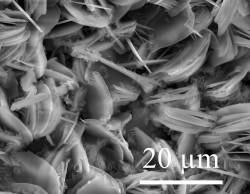Abstract
The present invention relates to the synthesis, by solid state reaction, of a turquoise ceramic pigment, free of cobalt, vanadium and zirconium. This pigment comprises calcium oxide, silica, alumina, tin oxide and nickel oxide, being this the chromophore component.
One of the formulations uses sludge from wastewater treatment plants of surface treatment industries (coating with chromium and nickel), to introduce the chromophore element, replacing the commercial nickel oxide. This hazardous waste can be introduced as it is received, but can also be prior dried or calcined.
Pigment processing steps are: raw materials dosing and homogenization; mixture calcination; washing and crushing. In accordance with the invention, blue colored ceramic pigments are obtained, which are thermostable, insoluble in glassy matrix and do not change the physical properties of the matrix, providing coloring to ceramic products.
Innovative aspects & main advantages
The present invention concerns to the synthesis, by solid state reaction of a turquoise ceramic pigment, free of cobalt, vanadium and zirconium. This pigment contains calcium oxide, silica, alumina, tin oxide and nickel oxide, where the latter is the chromophore component. The formulations use the sludge generated from wastewater treatment plants (of potable water, combined with the) sludge generated from metal plating (chromium and nickel) processes. The last one introduces the chromophore element, replacing pure/commercial nickel oxide.
In accordance with the work it is possible to obtain blue colored ceramic pigments complying with all required properties to be used as colorant of ceramic products and glasses.
Applications
The main application of this invention (the potential commercial/industrial sectors) is focused on the pigments producers, while the colorants might be applied in distinct products, such as ceramics, glazes and glasses.














